Results
-
 £109.50
£109.50Three London Sketches - David Campo
London is one of my favorite cities in the world, and in 2016 I was invited there to serve as an adjudicator for the London New Year's Day Parade and Gala Concerts. While I was there, I was fortunate to meet and spend time with The Lord Mayor of Westminster Councillor Steve Summers. While his title sounds formidable and intimidating, I found Steve to one of the nicest, most easygoing people I've ever met. And boy, does he love London! He was fond of saying that he had "the best job in the greatest city in the world." He spoke passionately about London and his favorite places in the city, and his enthusiasm was contagious. Some of his favorite places became some of my favorite places, and the inspiration for this piece. I hope that this work not only conveys the beauty and history of these iconic places, but Steve's deep and abiding love for them as well. I. Tower Bridge - The Tower Bridge was built over 120 years ago to ease road traffic while maintaining river access to the busy Pool of London docks. Its giant moveable roadways lift up for passing ships, making it a true engineering marvel. It is also one of the most iconic sites in London, and was used to display the Olympic Rings during the 2012 Olympics. II. St. Paul's (The Whispering Gallery) - The history of St. Paul's Cathedral goes back well over a thousand years, but construction on the current St. Paul's began in 1669 after a fire destroyed the earlier structure. The dome of St. Paul's Cathedral is a whispering gallery; you can whisper against the wall on the inside of the dome and it can be clearly heard on the other side of the dome over 100 ft. away. Imagine the secrets that have passed there... III. Trafalgar Square - The name commemorates the 1805 naval Battle of Trafalgar and is marked by Nelson's Column, a monument to Admiral Horatio Nelson, the hero of the Battle of Trafalgar. It is the heart of London; full of life and constant energy and home to iconic buildings including the National Gallery, St. Martin-in-the-Fields, Canada House and South Africa House. Londoners say that all roads in London lead to Trafalgar Square.
Estimated dispatch 7-14 working days
-
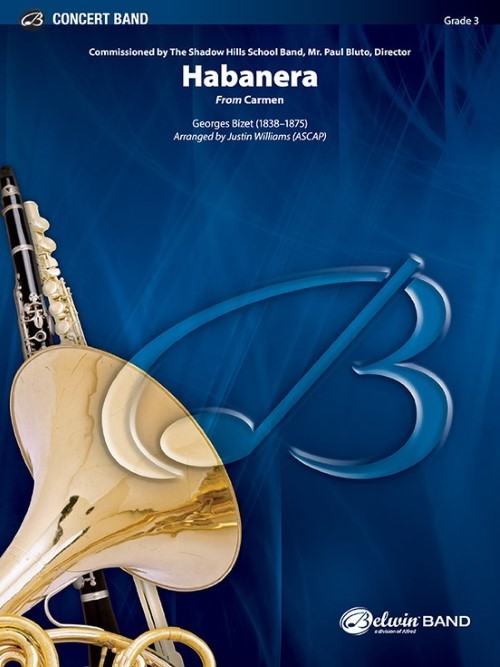 £64.50
£64.50Habanera (Concert Band - Score and Parts) - Bizet, Georges - Williams, Justin
French composer Georges Bizet's four-act opera, Carmen , remains one of the most popular and performed works in the classical canon. This piece is perhaps the most popular portion of the opera. Its playful character and flirtatious mood are exposed in this contemporary setting.Duration: 3:00
Estimated dispatch 7-14 working days
-
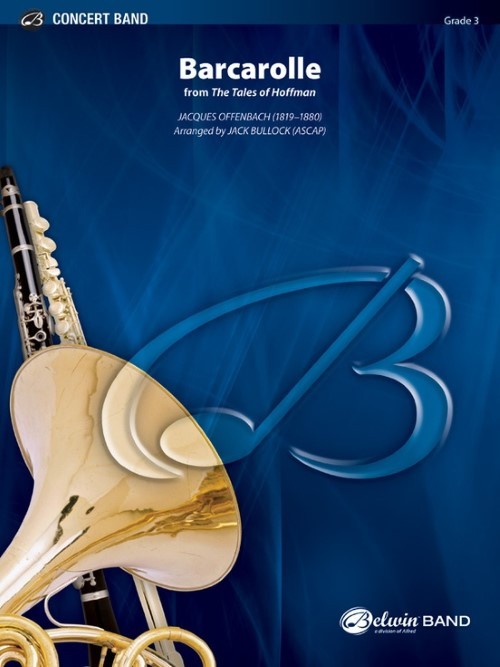 £66.95
£66.95Barcarolle (from Tales from Hoffman) (Concert Band - Score and Parts) - Offenbach, Jacques - Bullock, Jack
Barcarolle, one of the most famous operetta melodies, is presented here for concert band. Its "rolling" melody and simple harmonic structure have made it a favourite the world over. Written by one of the originators of the operetta musical form, Jacques Offenbach, it has endured for over 150 years. A historic work in a contemporary setting... a most musical gem!Duration: 2.45
Estimated dispatch 7-14 working days
-
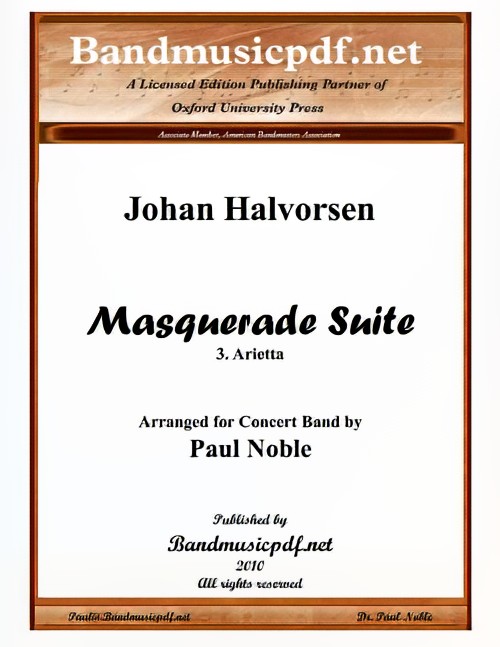 £75.00
£75.00Arietta (from Masquerade Suite) (Concert Band - Score and Parts) - Halvorsen, Johan - Noble, Paul
Masquerade Suite was composed by Johan Halvorsen, one of the best-kept secrets of Norway. Not only was he an accomplished violinist and conductor, but also he was among the most prominent Norwegian composers in the generation following Edvard Grieg. His compositions develop the national Romantic tradition of his friends Grieg and Svendsen, but his was a distinctive style marked by brilliant orchestration inspired by the French Romantic composers. The original version of Masquerade Suite had nine movements. Paul Noble has selected five of the most suitable movements for band transcription and grouped them into this beautiful suite. The U.S. Navy Band in Washington, D.C. gave the premiere performance of this work. The first movement, Holberg Overture, sets the mood, pace, and musical themes for the entire suite, with rousing opening themes, followed by a grand fugue in the development section. This is clearly a piece for accomplished bands, giving all wind players a real workout. Each of the succeeding movements has a distinctive style, making the suite a significant addition to the repertoire of the Concert Band. Especially noteworthy is the Arietta, the easiest of the movements, and can easily stand alone with its haunting flute and oboe melodies and dramatic crescendo, the crisp solos in the Molinasque, and the final movement, which is very much like a circus march, fast, lively and short!
Estimated dispatch 7-14 working days
-
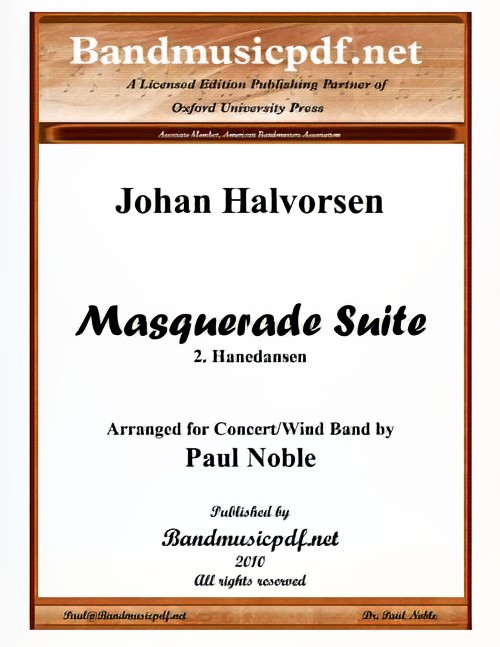 £75.00
£75.00Hanedansen (from Masquerade Suite) (Concert Band - Score and Parts) - Halvorsen, Johan - Noble, Paul
Masquerade Suite was composed by Johan Halvorsen, one of the best-kept secrets of Norway. Not only was he an accomplished violinist and conductor, but also he was among the most prominent Norwegian composers in the generation following Edvard Grieg. His compositions develop the national Romantic tradition of his friends Grieg and Svendsen, but his was a distinctive style marked by brilliant orchestration inspired by the French Romantic composers. The original version of Masquerade Suite had nine movements. Paul Noble has selected five of the most suitable movements for band transcription and grouped them into this beautiful suite. The U.S. Navy Band in Washington, D.C. gave the premiere performance of this work. The first movement, Holberg Overture, sets the mood, pace, and musical themes for the entire suite, with rousing opening themes, followed by a grand fugue in the development section. This is clearly a piece for accomplished bands, giving all wind players a real workout. Each of the succeeding movements has a distinctive style, making the suite a significant addition to the repertoire of the Concert Band. Especially noteworthy is the Arietta, the easiest of the movements, and can easily stand alone with its haunting flute and oboe melodies and dramatic crescendo, the crisp solos in the Molinasque, and the final movement, which is very much like a circus march, fast, lively and short!
Estimated dispatch 7-14 working days
-
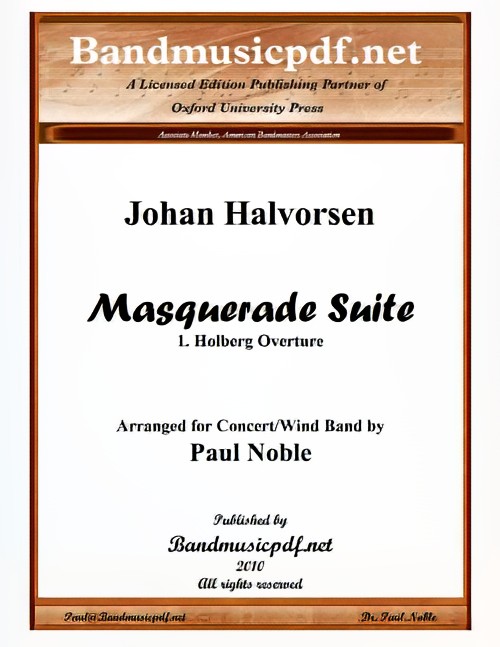 £75.00
£75.00Holberg Overture (from Masquerade Suite) (Concert Band - Score and Parts) - Halvorsen, Johan - Noble, Paul
Masquerade Suite was composed by Johan Halvorsen, one of the best-kept secrets of Norway. Not only was he an accomplished violinist and conductor, but also he was among the most prominent Norwegian composers in the generation following Edvard Grieg. His compositions develop the national Romantic tradition of his friends Grieg and Svendsen, but his was a distinctive style marked by brilliant orchestration inspired by the French Romantic composers. The original version of Masquerade Suite had nine movements. Paul Noble has selected five of the most suitable movements for band transcription and grouped them into this beautiful suite. The U.S. Navy Band in Washington, D.C. gave the premiere performance of this work. The first movement, Holberg Overture, sets the mood, pace, and musical themes for the entire suite, with rousing opening themes, followed by a grand fugue in the development section. This is clearly a piece for accomplished bands, giving all wind players a real workout. Each of the succeeding movements has a distinctive style, making the suite a significant addition to the repertoire of the Concert Band. Especially noteworthy is the Arietta, the easiest of the movements, and can easily stand alone with its haunting flute and oboe melodies and dramatic crescendo, the crisp solos in the Molinasque, and the final movement, which is very much like a circus march, fast, lively and short!
Estimated dispatch 7-14 working days
-
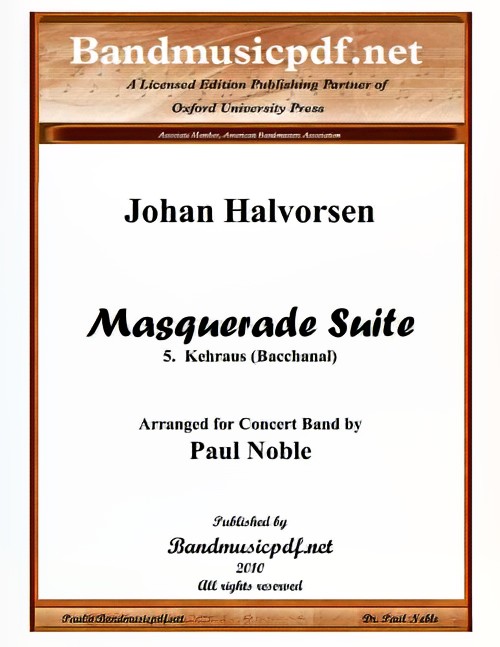 £65.00
£65.00Kehraus (from Masquerade Suite) (Concert Band - Score and Parts) - Halvorsen, Johan - Noble, Paul
Masquerade Suite was composed by Johan Halvorsen, one of the best-kept secrets of Norway. Not only was he an accomplished violinist and conductor, but also he was among the most prominent Norwegian composers in the generation following Edvard Grieg. His compositions develop the national Romantic tradition of his friends Grieg and Svendsen, but his was a distinctive style marked by brilliant orchestration inspired by the French Romantic composers. The original version of Masquerade Suite had nine movements. Paul Noble has selected five of the most suitable movements for band transcription and grouped them into this beautiful suite. The U.S. Navy Band in Washington, D.C. gave the premiere performance of this work. The first movement, Holberg Overture, sets the mood, pace, and musical themes for the entire suite, with rousing opening themes, followed by a grand fugue in the development section. This is clearly a piece for accomplished bands, giving all wind players a real workout. Each of the succeeding movements has a distinctive style, making the suite a significant addition to the repertoire of the Concert Band. Especially noteworthy is the Arietta, the easiest of the movements, and can easily stand alone with its haunting flute and oboe melodies and dramatic crescendo, the crisp solos in the Molinasque, and the final movement, which is very much like a circus march, fast, lively and short!
Estimated dispatch 7-14 working days
-
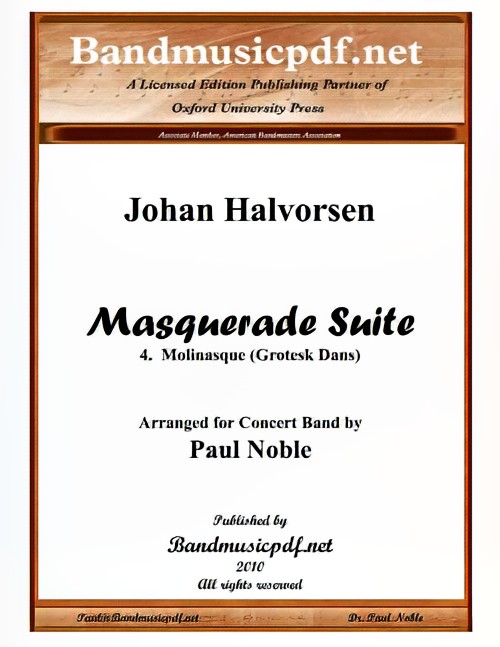 £75.00
£75.00Molinasque (from Masquerade Suite) (Concert Band - Score and Parts) - Halvorsen, Johan - Noble, Paul
Masquerade Suite was composed by Johan Halvorsen, one of the best-kept secrets of Norway. Not only was he an accomplished violinist and conductor, but also he was among the most prominent Norwegian composers in the generation following Edvard Grieg. His compositions develop the national Romantic tradition of his friends Grieg and Svendsen, but his was a distinctive style marked by brilliant orchestration inspired by the French Romantic composers. The original version of Masquerade Suite had nine movements. Paul Noble has selected five of the most suitable movements for band transcription and grouped them into this beautiful suite. The U.S. Navy Band in Washington, D.C. gave the premiere performance of this work. The first movement, Holberg Overture, sets the mood, pace, and musical themes for the entire suite, with rousing opening themes, followed by a grand fugue in the development section. This is clearly a piece for accomplished bands, giving all wind players a real workout. Each of the succeeding movements has a distinctive style, making the suite a significant addition to the repertoire of the Concert Band. Especially noteworthy is the Arietta, the easiest of the movements, and can easily stand alone with its haunting flute and oboe melodies and dramatic crescendo, the crisp solos in the Molinasque, and the final movement, which is very much like a circus march, fast, lively and short!
Estimated dispatch 7-14 working days
-
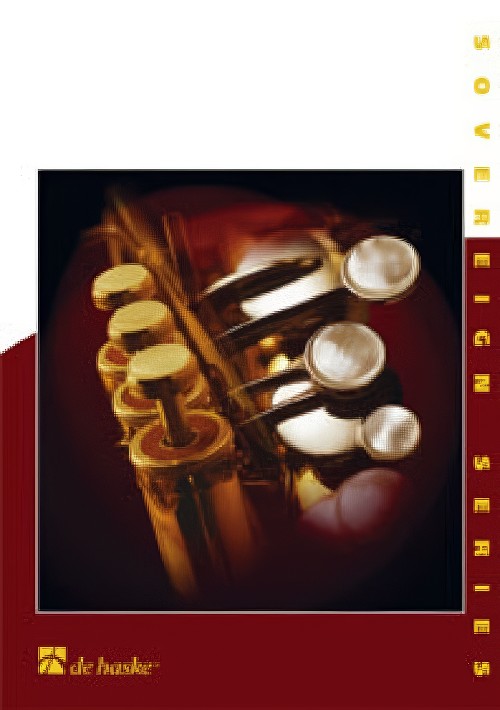 £134.99
£134.99Milestone Overture (Concert Band - Score and Parts) - Brosse, Dirk
This work was written at the pivotal point of both two centuries and two millennia. With its hopeful melodies and triumphant parts in the brass section, the opening pictures the dawning of a new era of great expectations, characterized by the high speed of communicating all over the world, which is one of the most important aspects of life in the 21st century. This is achieved by musical themes being rapidly transferred from one musician to another. In this vortex of information and fast business transactions, the sense of individuality threatens to become extinct. At this point, Brosse silences the orchestra (a symbol of society) and draws attention to those people who are less fortunate than most of us. This focus on other people culminates with an orchestral climax in which all powers come together with a feeling of euphoria.Duration: 7:45
Estimated dispatch 7-14 working days
-
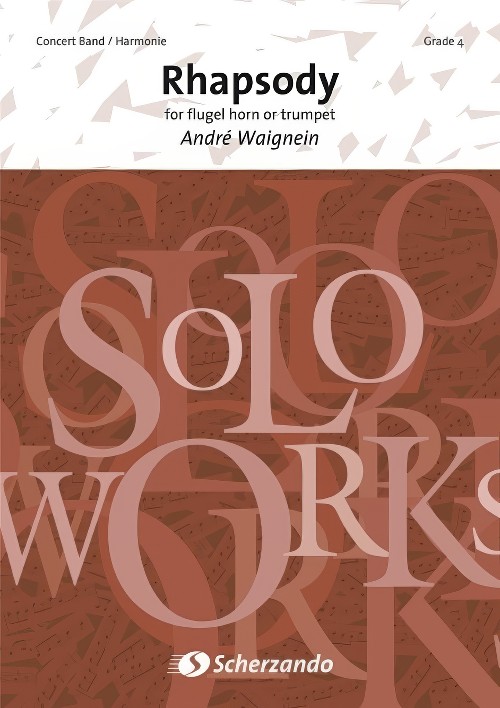 £134.99
£134.99Rhapsody (Flugel Horn or Trumpet Solo with Concert Band - Score and Parts) - Waignein, Andre
As a trumpet player Andre Waignein has composed many pieces for this instrument; extremely electrifying pieces meant for young trumpet-players, and more demanding works for professionals.With his rhapsody Andre Waignein wanted to compose a piece in which spontaneity dominates and in which the virtuosity, sonority and style of the soloist is featured to its maximum. Although the piece is not one of the most difficult, it nevertheless places high musical demands on the soloist. Following an impressive orchestral opening the soloist comes to the fore, with long phrases followed by more dynamic and rhythmic passages. The second movement gives evidence of extreme sensitivity and offers the soloist the opportunity to prove that the trumpet (flugel horn) can be a stirring and emotional instrument. The third movement is the most spectacular. The orchestra actively participates with increasingly delicate interventions. The soloist can display all the possibilities offered to him by his instrument. With a long sostenuto on the trumpet (flugel horn) the beautiful rhapsody ends.Duration: 6:00
Estimated dispatch 7-14 working days
